Corn snakes are colorful snakes native to the Southeastern United States. These snakes are a North American species of rat snake. In some areas, people call them “red rat snakes” because of their bright red, orange, and yellowish-brown colors. Sometimes people mistake wild corn snakes for venomous copperhead snakes. However, not only are corn snakes calm and docile, but they are nonvenomous and completely harmless to humans.
In fact, corn snakes are very popular pets, and come in a seemingly infinite range of different colors. These snakes usually don’t grow more than 4 feet long in captivity, but of course, there have been many corn snakes that were much longer. So, just how long is the largest corn snake ever recorded?
What do Corn Snakes Look Like?
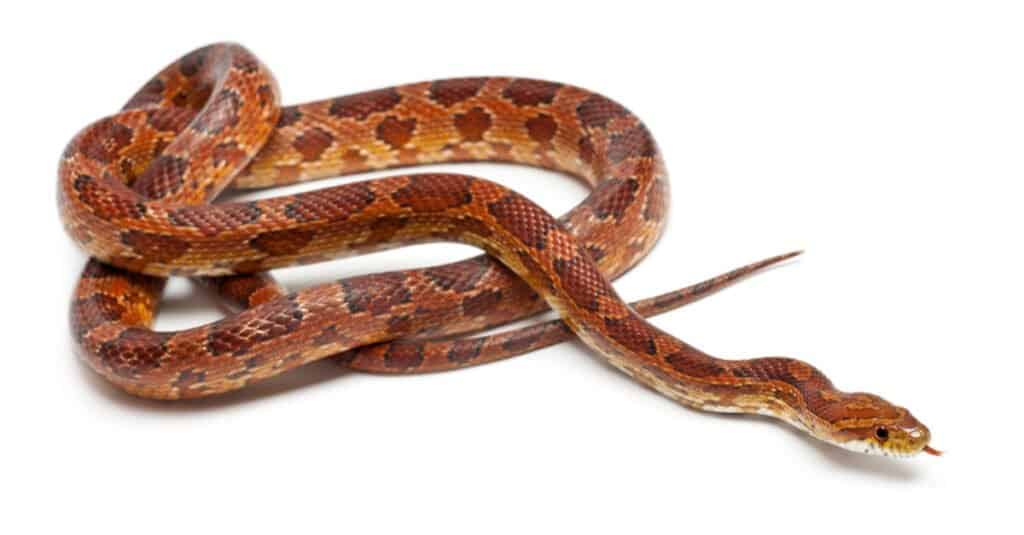
Corn snakes are possibly named for the pattern on their belly scales that looks like maize.
©Eric Isselee/Shutterstock.com
In the wild, corn snakes are usually red, orange, or brownish-yellow color. There are red blotches with black edges that run along the length of their bodies. Young corn snakes are typically darker and have more brown tones. As they age, their colors brighten. Depending on their age and where they live, the colors and patterns of corn snakes will vary. Pet corn snakes, on the other hand, have been selectively bred and come in an endless array of different colors, morphs, and patterns. Corn snakes are usually between 24-48 inches in length, although the longest corn snake ever recorded was much longer.
The head of a corn snake typically has a spear-shaped blotch on top. Their bellies have bold black and white alternating checkerboard-like patterns. Some say that this uniquely patterned belly looks like variegated corn, which is where the corn snake gets its name. However, another theory is that the corn snake got its name because it spends time in corn fields, as well as in barns near grain storage and corn feed. These snakes are common both in barns and agricultural fields where they hunt mice and rats.
Corn Snakes vs. Copperhead Snakes
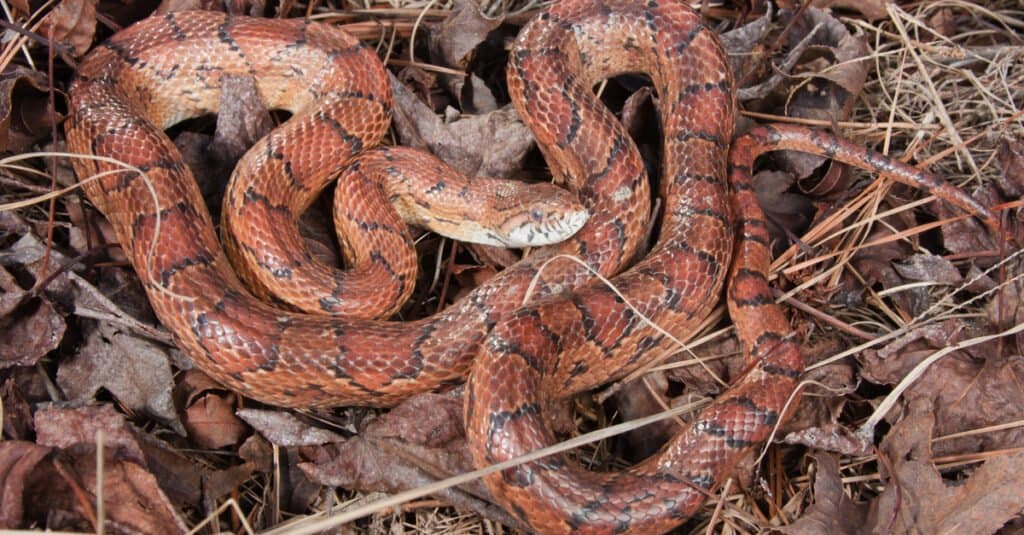
Corn snakes sound like rattlesnakes when they vibrate their tails in leaf litter.
©Nathan A Shepard/Shutterstock.com
Those who are unfamiliar with these snakes can sometimes mistake a harmless corn snake for the venomous copperhead snake. However, corn snakes and copperhead snakes are actually very different in appearance. It is important to become familiar with these snakes so that both you and the snakes can stay safe. Here are a few distinct differences between corn snakes and copperhead snakes:
- Copperhead snakes have even blotches shaped like an hourglass running along the length of their bodies.
- Corn snakes also have blotches along the length of their bodies. However, these markings are random and do not have a uniform shape.
- Copperhead snakes do not have the iconic black and white checkered belly that corn snakes are famous for.
Of course, if you see either of these snakes in the wild, it is always best to leave it alone, no matter what species it is.
What is the Largest Corn Snake Ever Recorded?
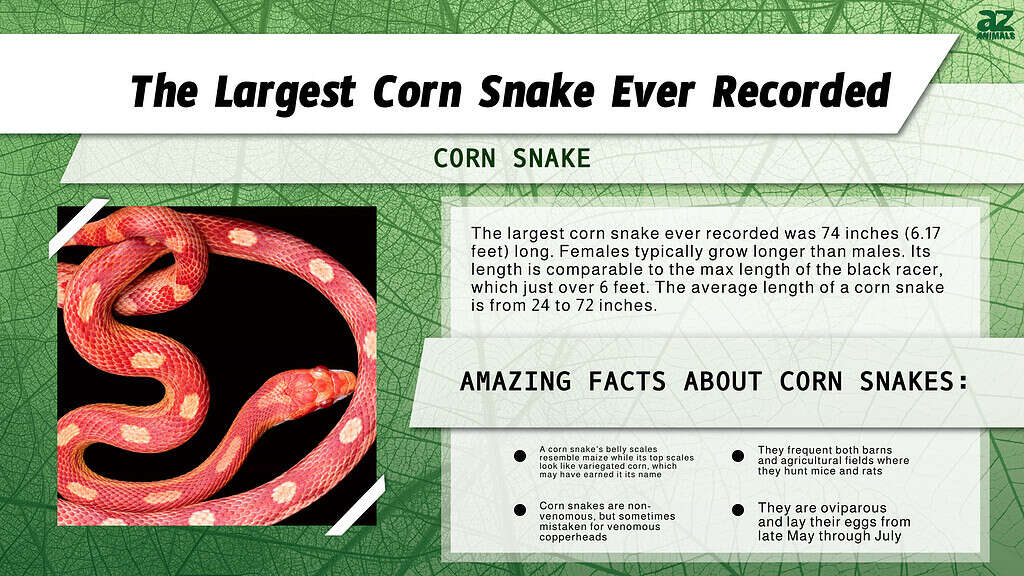
Corn snakes can be anywhere between 24-72 inches in length, although most do not grow longer than 48 inches. However, the largest corn snake ever recorded was 74 inches long!
In general, female corn snakes grow larger than males. The length of the largest corn snake is comparable to another snake species found in the Southeastern United States: the black racer. Similar to the largest corn snake, black racers have a maximum length that’s slightly longer than 6 feet long. It’s worth noting that the largest copperhead ever measured was just 4 feet 5 inches (53 inches). While copperheads aren’t as lengthy as the longest corn snakes, they are wider.
Baby corn snakes, on the other hand, are only 10-15 inches long when they are born. Corn snakes are oviparous and lay their eggs from late May through July. Female corn snakes lay 10-30 eggs in hidden areas with plenty of humidity and heat, like decaying vegetation and rotting stumps. Baby corn snakes hatch between July and September and are completely independent as soon as they emerge from their shells.
Where do Corn Snakes Live?

Outside of the United States corn snakes are often called “American corn snakes.”
©fivespots/Shutterstock.com
Corn snakes are native to the Southeastern United States. There are especially high numbers of these snakes in Florida, where they are a species of special concern. State laws in Georgia also protect wild corn snakes.
In addition, corn snakes have more recently been observed in areas outside of the United States, possibly from escaped pets that adapted back to the wild and reproduced. Corn snakes are extremely adaptable and can adjust to many different types of environments. Observers report established populations of corn snakes on some of the Caribbean islands, the Bahamas, the U.S. Virgin Islands, and even Australia.
Corn snakes often live on rocky hillsides and open areas, as well as woodlands, meadows, longleaf pine forests, tropical hammocks, and flatwoods. Many corn snakes will even move into abandoned buildings and barns where mice and rats are plentiful. When it gets too hot in the summer, corn snakes often seek shelter in cooler areas under logs, sheet metal, and wood boards, as well as in rodent burrows and stump holes.
These snakes are usually more active during the day and will even climb trees in search of prey. However, corn snakes are also surprisingly secretive. These snakes spend most of their lives hiding under rocks, loose bark, and underground mammal burrows.
Are Corn Snakes Dangerous?
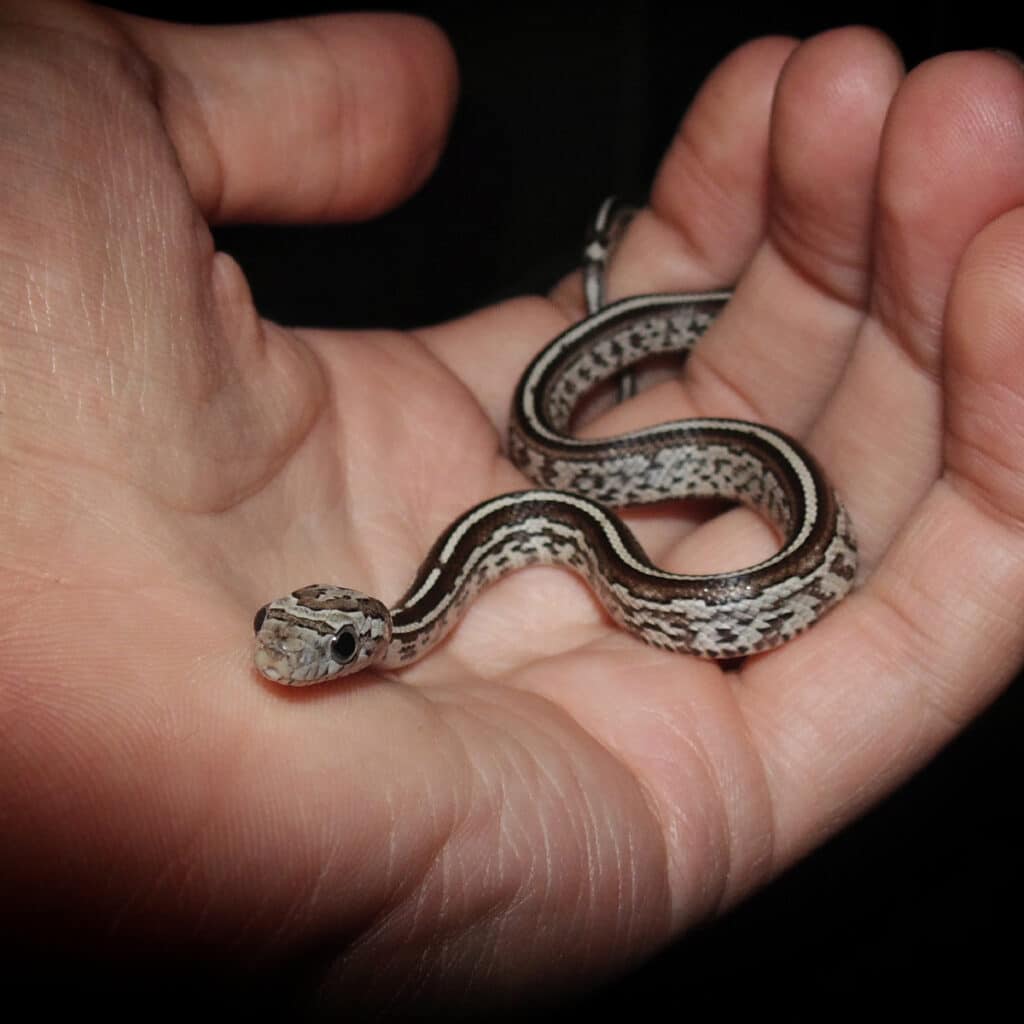
Baby corn snakes are 10-15 inches long when they are born.
©PauloPadrao/Shutterstock.com
Corn snakes are not at all dangerous to humans or pets. These snakes are not venomous, and although they can bite, it is not common. Corn snakes are a very popular pet because of their calm temperament. Many farmers also keep corn snakes on their property to help control populations of wild rats and mice that would otherwise spread disease and damage their crops.
When threatened, a corn snake may coil up and vibrate its tail, mimicking a rattlesnake. Although nonvenomous, corn snakes can still bite. They have a surprisingly long striking range—up to 1/3 or 1/2 of their body length! However, corn snakes are reluctant to bite. They will usually attempt to flee or intimidate before ever striking.
What Do Corn Snakes Eat?
Corn snakes are constrictors that swallow their prey whole. These snakes are particularly fond of rodents, but they will also eat bats and birds. Young corn snakes tend to eat smaller animals like frogs and lizards.
Corn Snakes as Pets
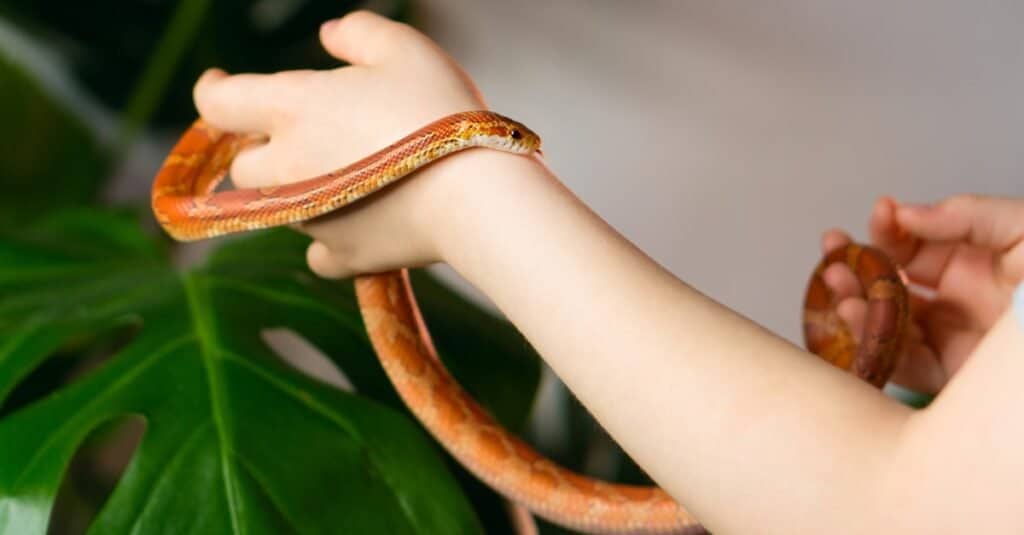
For beginner snake owners, corn snakes are probably the best option.
©iStock.com/Vagengeym_Elena
Corn snakes are very popular pets because they have beautiful colors and patterns, a very calm temperament, and are fairly easy to care for. In fact, corn snakes are one of the most popular snakes to keep as a pet, second only to ball pythons. The largest corn snake ever recorded was 74 inches long, but most pet corn snakes do not grow beyond 48 inches or so in length. Corn snakes are not prone to biting and they are nonvenomous. Although these snakes can be fearful and shy at first, with proper care they can become quite comfortable with human interaction.
Corn snakes are highly intelligent and quick to learn, navigating their surroundings with ease. This is perhaps the most challenging aspect of owning a pet corn snake—they are exceptional escape artists! If a corn snake can squeeze its head through an opening, you can be sure that it will inevitably escape. In addition, corn snakes are quite resourceful and extremely clever. Many pet owners are shocked when they discover that their corn snake can even manipulate locks!
Despite their propensity for escaping, corn snakes make great pets. Although their lifespan in the wild is typically 6-8 years due to predators and lack of food, with proper care, a pet corn snake can live up to 15-20 years! In fact, the oldest pet corn snake lived to be 32 years and three months old! The best pet corn snakes are captive-bred rather than wild-caught. Captive-bred corn snakes are selectively bred for health and temperament and do not bring diseases from the wild. In addition, in many areas, it is illegal to capture a corn snake from the wild.
A Kaleidoscope of Corn Snakes

Albino corn snakes are popular color morphs.
©iStock.com/mynewturtle
Because of their popularity as pets and selective breeding, there are now over 800 different color morphs and variations of these snakes. Natural colors seen in “wild” corn snakes are common of course, such as brown, yellowish-brown, grey, and orange, with dark blotches along the length of the snake’s body. Motley color morphs, on the other hand, have the opposite pattern of wild corn snakes. Instead of the iconic black and white checkered pattern of wild corn snakes, Motley corn snakes have a plain white belly. Patterns along the snake’s back are smaller and fainter as well.
Albino corn snakes are also popular, with light pink and cream bodies and red eyes. Another morph, the Hypo melanistic corn snake, has little to no black coloring on its scales. Striped corn snakes come in a wide variety of colors, with well-defined stripes running vertically along the length of their bodies instead of spots or blotches. Lavender corn snakes are quite popular as well. When they are born these snakes are grey, but as they age their scales transition into a light lavender color with silver botches.
Of course, these are only a handful of the many, MANY different types, colors, and patterns of pet corn snakes out there. Whatever color you can imagine, you can probably find a pet corn snake to match.
Other Record-Breaking Snakes

Like corn snakes, milk snakes make great pets.
©Siarhei Kasilau/Shutterstock.com
After reading about the good-natured corn snake, you may want to learn about another sweet-tempered beauty – the milk snake. At first glance, this exotic-looking reptile resembles the venomous coral snake – and this is no accident! The colors and patterns of their scales are a form of Batesian mimicry – when a harmless animal mimics the appearance of a dangerous one to frighten potential predators. This offers great protection against other animals – but unfortunately for the milk snake, it often gets mistaken for the dangerous coral snake and is killed by frightened humans.
Milk snakes are strikingly beautiful, brightly colored reptiles with banded or blotched patterns in some variation of red, black, yellow, and white. Their scales are smooth and shiny – making them even more appealing. Like corn snakes, milk snakes may have gotten their name because they tend to live in or around barns on farms – where mice are plentiful. Milk snakes also eat other small mammals, birds, frogs, snakes, fish, eggs, and lizards. Some milk snakes are especially fond of skinks.
Out of the 24 types of milk snakes, the Honduran milk snake is most often bred to be a pet. This snake is docile and easy to handle and is considered to be a good snake for beginners. So, we know that like corn snakes, milk snakes bred in captivity made great pets, they are often mistaken for other dangerous snakes, and they are harmless to humans. How big do they get? The black milk snake holds the record for the largest milk snake ever recorded – and it was over 6 feet long! Read the next post to find out just how big a milk snake can get – and discover more about this magnificent mimicking reptile.
The photo featured at the top of this post is © Kurit afshen/Shutterstock.com
Discover the "Monster" Snake 5X Bigger than an Anaconda
Every day A-Z Animals sends out some of the most incredible facts in the world from our free newsletter. Want to discover the 10 most beautiful snakes in the world, a "snake island" where you're never more than 3 feet from danger, or a "monster" snake 5X larger than an anaconda? Then sign up right now and you'll start receiving our daily newsletter absolutely free.
Thank you for reading! Have some feedback for us? Contact the AZ Animals editorial team.






